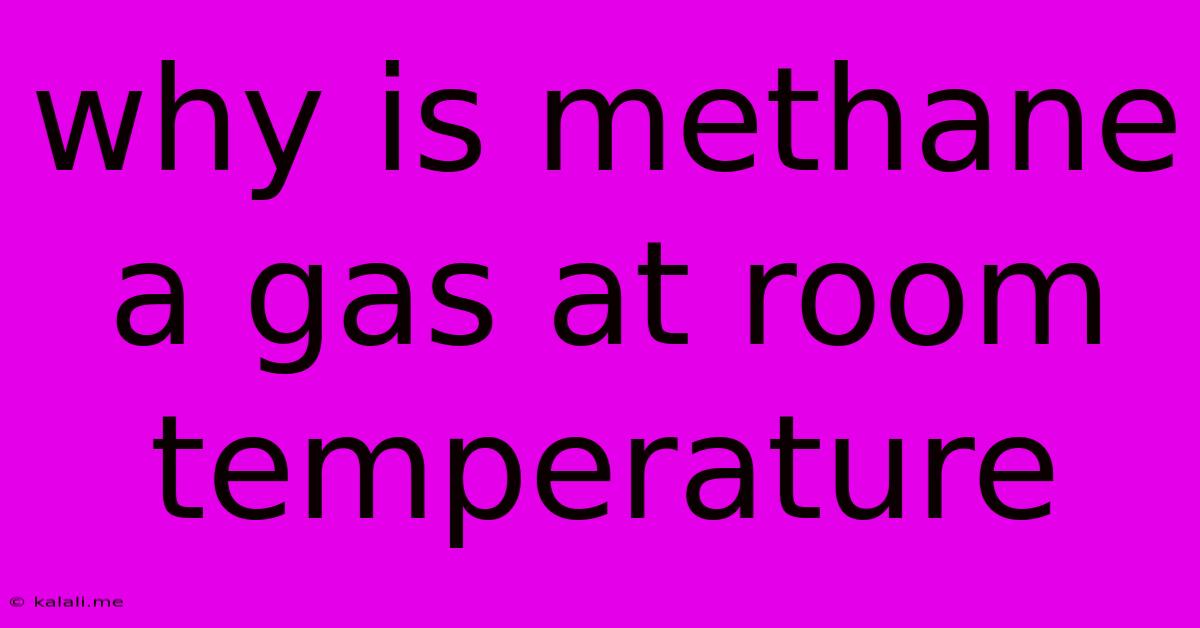Why Is Methane A Gas At Room Temperature
Kalali
May 21, 2025 · 3 min read

Table of Contents
Why is Methane a Gas at Room Temperature? Understanding Intermolecular Forces
Methane (CH₄), the simplest hydrocarbon, exists as a gas at room temperature. This seemingly simple fact is actually a consequence of the relatively weak intermolecular forces between methane molecules. Understanding these forces is key to comprehending its gaseous state. This article delves into the molecular structure and the types of intermolecular interactions that determine methane's physical properties at room temperature.
Understanding Intermolecular Forces
Intermolecular forces are the attractive forces that exist between molecules. These forces are crucial in determining a substance's physical state (solid, liquid, or gas) at a given temperature and pressure. Stronger intermolecular forces generally lead to higher melting and boiling points because more energy is required to overcome these attractions and transition to a higher energy state. Conversely, weaker intermolecular forces result in lower melting and boiling points, often leading to a gaseous state at room temperature.
Methane's Molecular Structure and Weak Interactions
Methane is a tetrahedral molecule with a carbon atom at its center bonded to four hydrogen atoms. This symmetrical structure is crucial. The carbon-hydrogen bonds are nonpolar covalent bonds due to the relatively small difference in electronegativity between carbon and hydrogen. As a result, the methane molecule itself is essentially nonpolar.
Because methane is nonpolar, the primary intermolecular forces present are London Dispersion Forces (LDFs), also known as van der Waals forces. These are the weakest type of intermolecular force. LDFs arise from temporary, instantaneous dipoles that occur due to the random movement of electrons within the molecule. These temporary dipoles induce dipoles in neighboring molecules, resulting in weak attractive forces. While present in all molecules, LDFs are the only intermolecular forces present in nonpolar molecules like methane.
Comparing Methane to Other Substances
To further illustrate why methane is a gas at room temperature, let's compare it to substances with stronger intermolecular forces:
-
Water (H₂O): Water molecules have strong hydrogen bonds, a special type of dipole-dipole interaction. Hydrogen bonds are significantly stronger than LDFs, leading to water's higher boiling point (100°C) and liquid state at room temperature.
-
Ammonia (NH₃): Ammonia molecules exhibit dipole-dipole interactions and hydrogen bonding, resulting in a higher boiling point (-33°C) than methane.
The relatively weak LDFs in methane are easily overcome by the kinetic energy of the molecules at room temperature (approximately 25°C). This allows the methane molecules to move freely and independently, resulting in its gaseous state.
Conclusion
The gaseous nature of methane at room temperature stems directly from the weak London Dispersion Forces between its nonpolar molecules. The symmetrical tetrahedral structure and the nonpolar nature of its bonds contribute to the absence of stronger intermolecular forces like dipole-dipole interactions or hydrogen bonding. This results in a low boiling point, well below room temperature, causing methane to exist as a gas under typical conditions. Understanding these intermolecular forces provides a fundamental explanation for the physical properties of methane and other molecules.
Latest Posts
Latest Posts
-
One Tick On Whatsapp But Not Blocked
May 21, 2025
-
Can I Bring Toothpaste On My Carry On
May 21, 2025
-
How To Turn Off Motorola G13
May 21, 2025
-
Jesus Was Asleep In The Boat
May 21, 2025
-
How To Change Your Phone Number Iphone
May 21, 2025
Related Post
Thank you for visiting our website which covers about Why Is Methane A Gas At Room Temperature . We hope the information provided has been useful to you. Feel free to contact us if you have any questions or need further assistance. See you next time and don't miss to bookmark.